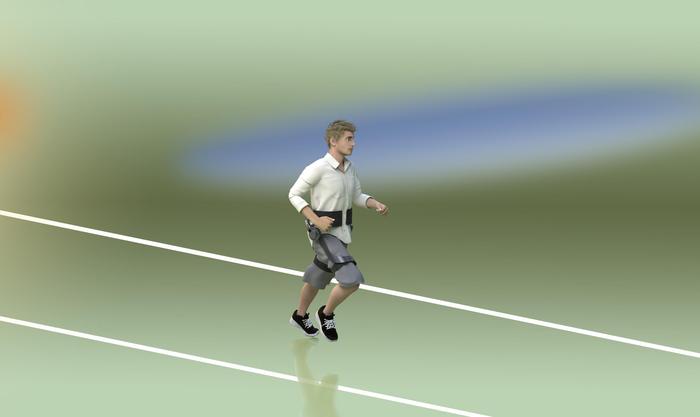A team of researchers have demonstrated a new method that leverages AI and computer simulations to train robotic exoskeletons that can help users save energy while walking, running, and climbing stairs. Described in a study published in Nature, the novel method rapidly develops exoskeleton controllers to assist locomotion without relying on lengthy human-involved experiments.

Credit: New Jersey Institute of Technology
A team of researchers have demonstrated a new method that leverages AI and computer simulations to train robotic exoskeletons that can help users save energy while walking, running, and climbing stairs. Described in a study published in Nature, the novel method rapidly develops exoskeleton controllers to assist locomotion without relying on lengthy human-involved experiments.
Moreover, the method can apply to a wide variety of assistive devices beyond the hip exoskeleton demonstrated in this research.
“It can also apply to knee or ankle exoskeletons, or other multi-joint exoskeletons,” said Xianlian Zhou, associate professor and director of NJIT’s BioDynamics Lab. In addition, it can similarly be applied to above-the-knee or below-the-knee prosthesis, providing immediate benefits for millions of able-bodied and mobility-impaired individuals, he said.
“Our approach marks a significant advancement in wearable robotics, as our exoskeleton controller is exclusively developed through AI-driven simulations,” Zhou explains. “Moreover, this controller seamlessly transitions to hardware without requiring further human subject testing, rendering it experiment-free.”
This breakthrough holds promise for aiding individuals with mobility challenges, including the elderly or stroke survivors, without necessitating their presence in a laboratory or clinical setting for extensive testing. Ultimately, it paves the way for restoring mobility and enhancing accessibility for everyday in-home or community living.
“This work proposes and demonstrates a new method that uses physics-informed and data-driven reinforcement learning to control wearable robots in order to directly benefit humans,” says Hao Su, corresponding author of a paper on the work and an associate professor of mechanical and aerospace engineering at North Carolina State University.
Exoskeletons have potential to improve human locomotive performance across a wide variety of users, from injury rehabilitation to permanent assistance for people with disabilities. However, lengthy human tests and control laws have limited its broad adoption.
The researchers focused on improving autonomous control of embodied AI systems – which are systems where an AI program is integrated into a physical technology. This work focused on teaching robotic exoskeletons how to assist able-bodied people with a variety of movements, and expands on previous reinforcement learning based research for lower limb rehabilitation exoskeletons, also a collaborative effort between Zhou, Su and several others.
“Previous achievements in reinforcement learning have tended to focus primarily on simulation and board games, our method provides a foundation for turnkey solutions in controller development for wearable robots,” says Shuzhen Luo, assistant professor at Embry-Riddle Aeronautical University and the first author of both works. Luo previously worked as a postdoc at both Zhou’s and Su’s labs.
Normally, users have to spend hours “training” an exoskeleton so that the technology knows how much force is needed – and when to apply that force – to help users walk, run or climb stairs. The new method allows users to utilize the exoskeletons immediately because the closed-loop simulation incorporates both exoskeleton controller and physics models of musculoskeletal dynamics, human-robot interaction, and muscle reactions, thereby generating efficient and realistic data and iteratively learning better control policy in simulation.
The unit is pre-programmed to be ready to use right away, and it’s also possible to update the controller on the hardware if researchers make improvements in the lab through expanded simulations. Future prospects for this project include developing individualized, custom-tailored controllers that assist users for various activities of daily living.
“This work is essentially making science fiction reality – allowing people to burn less energy while conducting a variety of tasks,” says Su.
For example, in testing with human subjects, the researchers found that study participants used 24.3% less metabolic energy when walking in the robotic exoskeleton, compared to walking without the exoskeleton. Participants used 13.1% less energy when running in the exoskeleton, and 15.4% less energy when climbing stairs.
While this study focused on the researchers’ work with able-bodied people, the new method aims to help people with mobility impairments using assistive devices.
“Our framework may offer a generalizable and scalable strategy for the rapid development and widespread adoption of a variety of assistive robots for both able-bodied and mobility-impaired individuals,” Su says.
“We are in the early stages of testing the new method’s performance in robotic exoskeletons being used by older adults and people with neurological conditions, such as cerebral palsy. And we are also interested in exploring how the method could be used to improve the performance of robotic prosthetic devices.”
This research was done with support from the National Science Foundation under awards 1944655 and 2026622; the National Institute on Disability, Independent Living, and Rehabilitation Research, under award DRRP 90DPGE0019; the Administration for Community Living’s Switzer Research Fellowship Program; and the National Institutes of Health, under award 1R01EB035404.
Journal
Nature
Article Title
Experiment-free exoskeleton assistance via learning in simulation
Article Publication Date
12-Jun-2024



